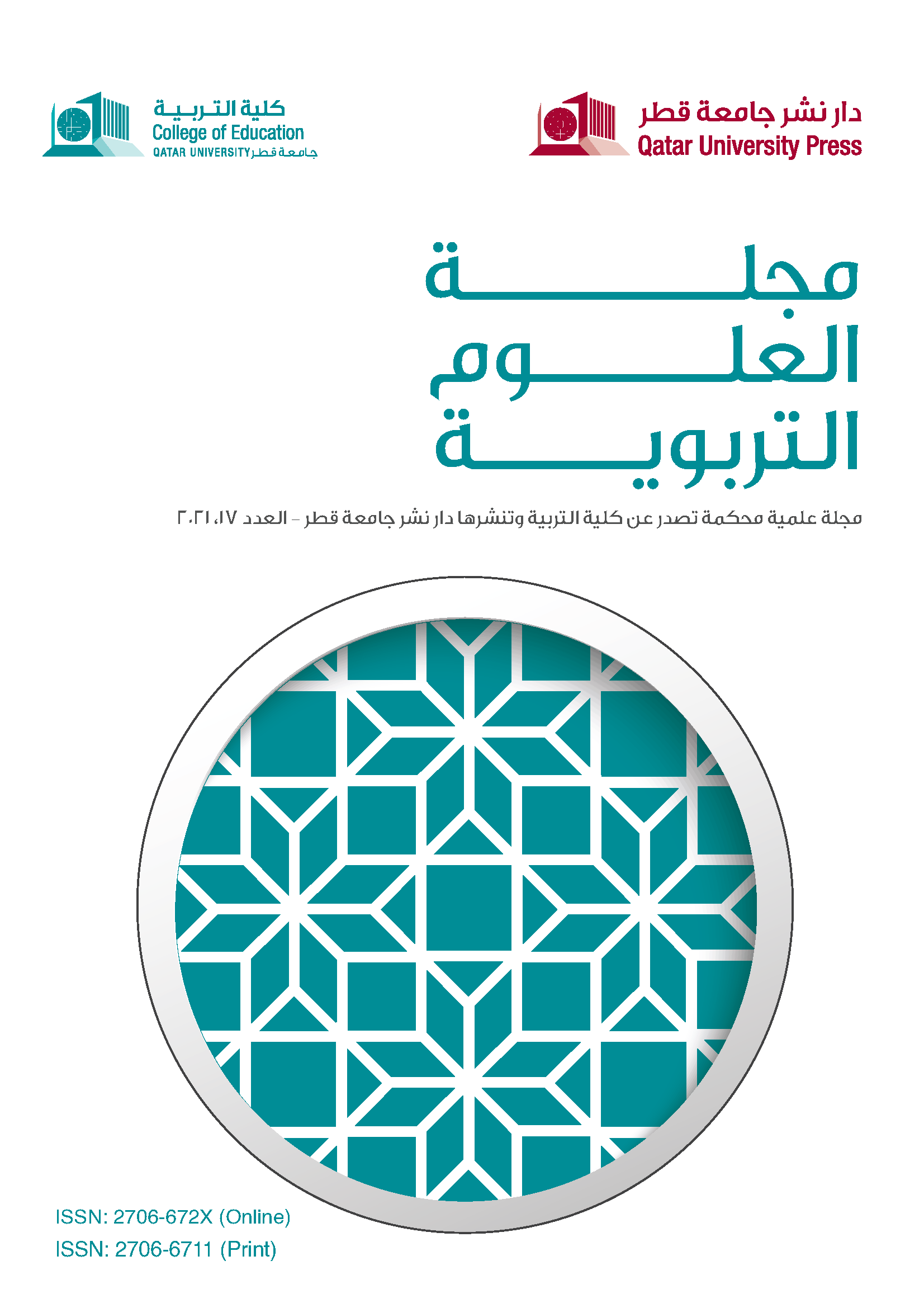البناء العاملي لمقياس "روزنبرغ" لتقدير الذات لدى عينة من طلبة المدرسة وأخرى من طلبة الجامعة في سلطنة عمان
الملخص
هدفت الدراسة الحالية إلى اختبار البنية العاملية لمقياس روزنبرغ لتقدير الذات، وفحص ما إذا كانت هذه البنية تتساوى لدى عينتين عمريتين. فقد أفادت دراسات عدة أن تقدير الذات ينمو ويتطور ويصبح أكثر واقعية وتمايزًا مع التقدم في العمر. وقد استجاب لمقياس تقدير الذات 365 طالبًا من طلبة المدارس و119 من طلبة الجامعة. يتكون مقياس تقدير الذات لروزنبرغ من 10 فقرات، نصفها تمت صياغته صياغة موجبة، والنصف الآخر تمت صياغته صياغة سالبة. وقد تبين أن مقياس تقدير الذات يتمتع بثبات مقبول لا سيما لدى طلبة الجامعة. وقد تبين أن المقياس يتمتع ببنية عاملية مقبولة لدى كل من العينتين، فقد تشبعت كل فقرات المقياس على عامل تقدير الذات بدرجة جوهرية. إلا أن وجود عامل واحد فقط؛ لم يمثل البيانات بشكل مقبول، فقد كان التطابق ضعيفًا بين العامل الواحد والبيانات. في حين أن وجود عاملين أحدهما موجب والآخر سالب، مثّلا البيانات بدرجة معقولة. ولكن عند اختبار فرضية تساوي المعالم لدى العينتين، اتضح أن المعالم التي تمثل التشبعات كانت متساوية لدى المجموعتين، بينما لم تتساو معالم الثوابت والبواقي والعلاقات بين البواقي. وخلصت الدراسة إلى أن النموذج الأكثر مطابقة للبيانات هو نموذج عامل السمة وعامل الطريقة السالبة في الصياغة، في إشارة إلى تأثير طريقة الصياغة على البنية العاملية، والدرجة التي يفرزها مقياس روزنبرغ. كما تبين الدراسة أهمية الانتباه إلى طريقة صياغة الفقرات عند تفسير الدرجات التي يفرزها هذا المقياس وغيره من المقاييس التي تحوي عبارات موجبة وأخرى سالبة.
المقاييس
##plugins.themes.bootstrap3.article.details##
سلطنة عمانطلبة الجامعةطلبة المدارستقدير الذاتالبناء العمليطريقة صياغة الفقرات
الشايب، عبد الحافظ. (2010). أثر طريقة صياغة فقرات الصورة المعربة لمقياس روزنبرغ لتقدير الذات في البناء العاملي للمقياس. المجلة الدولية للأبحاث التربوية، 28، 1-20.
Abu-Hilal, M. & Bahri, T. (2000). Self-concept: The generalizability of research on SDQ, Marsh/Shavelson, and I/E frame of reference model to the United Arab Emirates students. Social Behavior and Personality, 28, 309-322.
Abu-Hilal, M., Abdel Fattah, F., Shumrani, S., Abduljabbar, A. S. & Marsh, H. W. (2013). Construct validity of self-concept in TIMSS's student background questionnaire: a test of separation and conflation of cognitive and affective dimensions of self-concept among Saudi 8th graders. European Journal of Psychology of Education, 28(4), 1201-1220. Doi: 10.1007/s10212-012-01621.
Bagozzi, R. P. (1993). Assessing construct validity in personality research: Applications to measures of self-esteem. Journal of Research in Personality, 27, 49–87.
Bankston, C. L., III, & Zhou, M. (2002). Being well vs. doing well: self-esteem and school performance among immigrant racial and ethnic groups. International Migration Review, 36(2), 389–415. https://doi.org/10.1111/j.1747-7379.2002.tb00086.x
Campbell, D. T., & Fiske, D. (1959). Convergent and discriminant validation by the multitrait–multimethod matrix. Psychological Bulletin, 56, 81–105.
Cheung, G. W., & Rensvold, R. B. (2002). Evaluating goodness-of-fit indexes for testing measurement invariance. Structural Equation Modeling, 9, 233-255. doi: 10.1207/S15328007SEM0902_5
Dimitrov, D. M. (2010). Testing for factorial invariance in the context of construct validation. Measurement and Evaluation in Counseling and Development, 43, 121-149. doi: 10.1177/0748175610373459
DiStefano, C., & Motl, R. W. (2006). Further investigating method effects associated with negatively worded items on self-report surveys. Structural Equation Modeling, 13, 440–464.
Gnambs, T., & Schroeders, U. (2017). Cognitive Abilities Explain Wording Effects in the Rosenberg Self-Esteem Scale. Assessment, 1-15. Retrieved from: https://journals.sagepub.com/doi/abs/10.1177/1073191117746503?journalCode=asma
Gnambs, T., Scharl, A. & Schroeders, U. (2018). The Structure of the Rosenberg Self-Esteem Scale: A Cross-Cultural Meta-Analysis. Zeitschrift für Psychologie, 226(1), 14–29. https://doi.org/10.1027/2151-2604/a000317
Horan, P. M., DiStefano, C., & Motl, R. W. (2003). Wording effects in self-esteem scales: Methodological artifact or response style. Structural Equation Modeling, 10, 435–455. DOI: 10.1207/S15328007SEM1003_6
Lance, C. E., Noble, C. L., & Scullen, S. E. (2002). A critique of the correlated trait–correlated method and correlated uniqueness models of multitrait–multimethod data. Psychological Methods, 7, 228–244.
Marsh, H. W. (1996). Positive and negative global self-esteem: Substantively meaningful distinction or artifacts? Journal of Personality and Social Psychology, 70, 810-819.
Marsh, H. W., & Grayson, D. (1995). Latent variable models of multitrait–multimethod data. In R. H. Hoyle (Ed.), Structural equation modeling: Concepts, issues and application (pp. 177–198). Thousand Oaks, CA: Sage.
Marsh, H. W., Scalas, L. F., & Nagengast, B. (2010). Longitudinal tests of competing factor structures for the Rosenberg Self-Esteem Scale: Traits, ephemeral artifacts, and stable response styles. Psychological Assessment, 22(2), 366–381.
McKay, M., Boduszek, D., & Harvey, S. (2014). The Rosenberg Self-Esteem Scale: A bifactor answer to two-factor question? Journal of Personality Assessment, 96, 654-660. DOI: 10.1080/00223891.2014.923436
Michaelides, M. P., Koutsogiorgi, C., & Panayiotou, G. (2016). Method effects on an adaptation of the Rosenberg Self-Esteem Scale in Greek and the role of personality traits. Journal of Personality Assessment, 98(2), 178-188, DOI: 10.1080/00223891.2015.1089248
Pullmann, H., & Allik, J. (2000). The Rosenberg Self-Esteem Scale: its dimensionality, stability and personality correlates in Estonian. Personality and Individual Differences, 28, 701-715. doi:10.1016/j.paid.2008.06.017
Rosenberg, M. (1979). Conceiving the self. New York: Basic Books.
Schmitt, D. P., & Allik, J. (2005). Simultaneous administration of the Rosenberg Self-Esteem Scale in 53 nations: Exploring the universal and culture-specific features of global self-esteem. Journal of Personality and Social Psychology, 89, 623–642. http://dx.doi.org/10.1037/0022-3514.89.4.623
Tomás, J. M., & Oliver, A. (1999). Rosenberg’s Self-Esteem Scale: Two factors or method effects. Structural Equation Modeling, 6, 84–98. DOI: 10.1080/10705519909540120
Triandis, H. C. (2001). Modern educational needs cross-cultural psychology. In D. McInerney & S. V. Etten (Eds.), Research on sociocultural motivation and learning (Vol. 1, pp. 1–13). Greenwich, CT: Information Age.
Wang, J., Siegal, H. A., Falck, R. S., & Carlson, R. G. (2001). Factorial structure of Rosenberg’s Self-Esteem Scale among crack-cocaine drug users. Structural Equation Modeling, 8, 275–286.
Wu, C.-H. (2008). An examination of the wording effect in the Rosenberg Self-Esteem Scale among culturally Chinese people. Journal of Social Psychology, 148, 535–551. https://doi.org/10.3200/SOCP.148.5.535-552.


